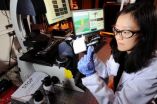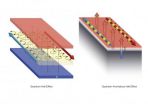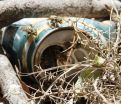(Press-News.org) Research into the genetic factors behind certain disease mechanisms, illness progression and response to new drugs is frequently carried out using tiny multi-cellular animals such as nematodes, fruit flies or zebra fish.
Often, progress relies on the microscopic visual examination of many individual animals to detect mutants worthy of further study.
Now, scientists have demonstrated an automated system that uses artificial intelligence and cutting-edge image processing to rapidly examine large numbers of individual Caenorhabditis elegans, a species of nematode widely used in biological research. Beyond replacing existing manual examination steps using microfluidics and automated hardware, the system's ability to detect subtle differences from worm-to-worm – without human intervention – can identify genetic mutations that might not have been detected otherwise.
By allowing thousands of worms to be examined autonomously in a fraction of the time required for conventional manual screening, the technique could change the way that high throughput genetic screening is carried out using C. elegans.
Details of the research were scheduled to be reported August 19th in the advance online publication of the journal Nature Methods. The research has been supported by the National Institutes of Health (NIH), the National Science Foundation (NSF) and the Alfred P. Sloan Foundation.
"While humans are very good at pattern recognition, computers are much better than humans at detecting subtle differences, such as small changes in the location of dots or slight variations in the brightness of an image," said Hang Lu, the project's lead researcher and an associate professor in the School of Chemical & Biomolecular Engineering at the Georgia Institute of Technology. "This technique found differences that would have been almost impossible to pick out by hand."
Lu's research team is studying genes that affect the formation and development of synapses in the worms, work that could have implications for understanding human brain development. The researchers use a model in which synapses of specific neurons are labeled by a fluorescent protein. Their research involves creating mutations in the genomes of thousands of worms and examining the resulting changes in the synapses. Mutant worms identified in this way are studied further to help understand what genes may have caused the changes in the synapses.
One aspect the researchers are studying is why synapses form in the wrong locations, or are of the wrong sizes or types. The differences between the mutants and the normal or "wild type" worms indicate inappropriate developmental patterns caused by the genetic mutations.
Because of the large number of possible genes involved in these developmental processes, the researchers must examine thousands of worms – perhaps as many as 100,000 – to exhaust the search. Lu and her research group had earlier developed a microfluidic "worm sorter" that speeds up the process of examining worms under a microscope, but until now, there were two options for detecting the mutants: a human had to look at each animal, or a simple heuristic algorithm was used to make the sorting decision. Neither option is objective or adaptable to new problems.
Lu's system, an optimized version of earlier work by her group, uses a camera to record three-dimensional images of each worm as it passes through the sorter. The system compares each image set against what it has been taught the "wild type" worms should look like. Worms that are even subtly different from normal can be sorted out for further study.
"We feed the program wild-type images, and it teaches itself to recognize what differentiates the wild type. It uses this information to determine what a mutant type may look like – which is information we didn't provide to the system – and sorts the worms based on that," explained Matthew Crane, a graduate student who performed the work. "We don't have to show the computer every possible mutant, and that is very powerful. And the computer never gets bored."
While the system was designed to sort C. elegans for a specific research project, Lu believes the machine learning technology – which is borrowed from computer science – could be applied to other areas of biology that use model genetic organisms. The system's hardware and software are currently being used in several other laboratories beyond Georgia Tech.
"Our automated technique can be generalized to anything that relies on detecting a morphometric – or shape, size or brightness difference," Lu said. "We can apply this to anything that can be detected visually, and we think this could be expanded to studying many other problems related to learning, memory, neuro-degeneration and neural developmental diseases that this worm can be used to model."
Individual C. elegans are less than a millimeter long and thinner than a strand of hair, but have 302 neurons with well-defined synapses. While research using single cells can be simpler to do, studies using the worms are good in vivo models for many important processes relevant to human health.
Other researchers who contributed to this paper include student Jeffrey Stirman from Georgia Tech's interdisciplinary program in bioengineering, Professor James Rehg from Georgia Tech's School of Interactive Computing, and three researchers from the Department of Biology at Stanford University's Howard Hughes Medical Institute: Chan-Yen Ou, Peri Kurshan, and Professor Kang Shen.
The autonomous processing facilitated by the new system could allow researchers to examine more animals more rapidly, potentially opening up areas of study that are not feasible today.
"We are hoping that the technology will really change the approach people can take to this kind of research," said Lu. "We expect that this approach will enable people to do much larger scale experiments that can push the science forward beyond looking what individual mutations are doing in a specific situation."
INFORMATION:
The project described was supported by Award Numbers R01GM088333, R21EB012803 and R01AG035317 from the National Institutes of Health. This material is also based on work supported by the National Science Foundation under Grant No. CAREER CBET-0954578. The content is solely the responsibility of the authors and does not necessarily represent the official views of the National lnstitutes of Health or the National Science Foundation.
Citation: Matthew M Crane, Jeffrey N Stirman, Chan-Yen Ou, Peri T Kurshan, James M Rehg, Kang Shen & Hang Lu, Autonomous screening of C. elegans identifies genes implicated in synaptogenesis, DOI: 10.1038/NMETH.2141
Artificial intelligence helps detect subtle differences in mutant worms
Automated worm sorter
2012-08-20
ELSE PRESS RELEASES FROM THIS DATE:
A new route to dissipationless electronics
2012-08-20
A team of researchers at RIKEN and the University of Tokyo has demonstrated a new material that promises to eliminate loss in electrical power transmission. The surprise is that their methodology for solving this classic energy problem is based upon the first realization of a highly exotic type of magnetic semiconductor first theorized less than a decade ago - a magnetic topological insulator.
Development of energy saving technologies is one of the central pursuits of modern science. From advancing alternative energy resources like wind and solar power to improving the ...
The wasp that never cries wolf
2012-08-20
European paper wasps (Polistes dominula) advertise the size of their poison glands to potential predators, finds a new study published in BioMed Central's open access journal Frontiers in Zoology. The brighter the colour, the larger the poison gland.
Aposematism is used by many different animals to warn potential predators that they are poisonous. Usually this takes the form of distinctive colouration or patterns which predators quickly learn to avoid. Paper wasps have conspicuous yellow and black patterns covering their bodies and researchers from University of Granada ...
Massachusetts butterflies move north as climate warms
2012-08-20
PETERSHAM, Mass. (August 19, 2012)---The authors of a Harvard study published today in Nature Climate Change gathered their data from an unlikely source—the trip accounts of the Massachusetts Butterfly Club. Over the past 19 years, the amateur naturalist group has logged species counts on nearly 20,000 expeditions throughout Massachusetts. Their records fill a crucial gap in the scientific record.
Once analyzed, the data show a clear trend. According to Greg Breed, lead author on the study and a post-doctoral fellow at the Harvard Forest in Petersham, Mass., "Over the ...
UCSB researchers demonstrate that 15=3x5 about half of the time
2012-08-20
(Santa Barbara, Calif.) — Computing prime factors may sound like an elementary math problem, but try it with a large number, say one that contains more than 600 digits, and the task becomes enormously challenging and impossibly time-consuming. Now, a group of researchers at UC Santa Barbara has designed and fabricated a quantum processor capable of factoring a composite number — in this case the number 15 — into its constituent prime factors, 3 and 5.
Although modest compared to a 600-digit number, the achievement represents a milestone on the road map to building a ...
Researchers assess stereotypes of immigrants and views on the impact of immigration
2012-08-20
DENVER — A new study led by the University of Cincinnati examines stereotypes of immigrants from four global regions and measures opinions of the impact of immigration on U.S. society. The researchers say their findings provide the most solid evidence yet that perceptions of the characteristics of Latin American immigrants in particular are strongly linked to beliefs about the impact of immigration, especially on unemployment, schools, and crime. The research will be presented at the 107th Annual Meeting of the American Sociological Association.
The study was conducted ...
Binge drinking college students are happier than their non-binge drinking peers
2012-08-20
DENVER — Why do some colleges have persistently high levels of binge drinking? It may be because, at these schools, binge drinking is associated with high status and binge drinkers are happier with their college social experience than their non-binge drinking peers, suggests new research to be presented at the 107th Annual Meeting of the American Sociological Association.
"Binge drinking is a symbolic proxy for high status in college," said Carolyn L. Hsu, co-author of the study and an associate professor of sociology at Colgate University. "It's what the most powerful, ...
Secondhand smoke impairs vital cough reflex in kids
2012-08-20
PHILADELPHIA (August 20, 2012) – New research from the Monell Center reveals that exposure to secondhand smoke decreases sensitivity to cough-eliciting respiratory irritants in otherwise healthy children and adolescents. The findings may help to explain why children of smokers are more likely to develop pneumonia, bronchitis and other diseases and also are more likely to experiment with smoking during adolescence.
"Cough protects our lungs from potentially damaging environmental threats, such as chemicals and dust. Living with a parent who smokes weakens this reflex, ...
JJ Schultz Releases 4th Studio Album
2012-08-20
JJ Schultz released his fourth studio album, Carolina, on Saturday August 11th. Following his albums Bustin' Outa Town, Something To Me, and Traveling Songs, Carolina features a stripped down Americana sound, communicating one man's struggle with love and manhood. With whiskey soaked lyrics, sparse guitars, and a heavenly Hammond B3, Schultz's Western Roots music weaves a lush, intricate mood.
The album features a combination of Schultz's solo work as well as numbers with his full band. On the solo tracks, Schultz's relaxed and almost casual guitar picking is accompanied ...
GiftWorksPlus Celebrates National Middle Child Day in August
2012-08-20
August is a busy time of year as summer activities begin to wane and preparations for back to school begin. Remember to treasure this time with your children—especially with the middle child who tends to "get lost in the shuffle."
As National Middle Child Day is celebrated in August, GiftWorksPlus recommends family picture frames to mark this event as well as other treasured moments that are here today and gone tomorrow. These custom wooden frames are engraved with names, dates, and personal messages at no additional cost. And, as always, these personalized ...
Nicholls Auction Marketing Group announces the Online Only Auction of Two Newport News, VA Investment Homes in the Marknet Alliance National Real Estate Auction
2012-08-20
"Properties marketed by NAMG will receive world wide exposure when included in the Marknet Alliance National Real Estate Auction," said John Nicholls, president of the company. "These are excellent investment properties or primary residences. The bidding will be done in an online only format, so bid early and bid often and be the new owners of these homes. Bidding ends on August 31."
"220 Buxton Street is a 3 bedroom, 770 sq. ft. income producing home on a .12 acre lot. The home's highlights include a fenced backyard, electric heat and vinyl ...
LAST 30 PRESS RELEASES:
New species of tiny pumpkin toadlet discovered in Brazil highlights need for conservation in the mountain forests of Serra do Quiriri
Reciprocity matters--people were more supportive of climate policies in their country if they believed other countries were making significant efforts themselves
Stanford Medicine study shows why mRNA-based COVID-19 vaccines can cause myocarditis
Biobanking opens new windows into human evolution
Sky-high smoke
AI tips off scientists to new drug target to fight, treat mpox
USC researchers develop next-generation CAR T cells that show stronger, safer response in animal models
New study reveals Industrial Revolution’s uneven health impacts across England
Vine-inspired robotic gripper gently lifts heavy and fragile objects
Fingerprint of ancient seafarer found on Scandinavia’s oldest plank boat
Lunar soil analyses reveal how space weathering shapes the Moon’s ultraviolet reflectance
Einstein’s theory comes wrapped up with a bow: astronomers spot star “wobbling” around black hole
Danforth Plant Science Center to lead multi-disciplinary research to enhance stress resilience in bioenergy sorghum
Home-delivered groceries improve blood sugar control for people with diabetes facing food insecurity
MIT researchers identified three cognitive skills we use to infer what someone really means
The Iberian Peninsula is rotating clockwise according to new geodynamic data
SwRI, Trinity University to study stable bacterial proteins in search of medical advances
NIH-led study reveals role of mobile DNA elements in lung cancer progression
Stanford Medicine-led study identifies immune switch critical to autoimmunity, cancer
Research Alert: How the Immune System Stalls Weight Loss
Glucagon-like peptide 1 receptor agonist use and vertebral fracture risk in type 2 diabetes
Nonadherence to cervical cancer screening guidelines in commercially insured US adults
Contraception and castration linked to longer lifespan
An old jeweler’s trick could unlock next-generation nuclear clocks
Older age, chronic kidney disease and cerebrovascular disease linked with increased risk for paralysis and death after West Nile virus infection
New immune role discovered for specialized gut cells linked to celiac disease
A new ‘hypertropical’ climate is emerging in the Amazon
Integrated piezoelectric vibration and in situ force sensing for low-trauma tissue penetration
Three-hit model describes the causes of autism
Beech trees use seasonal soil moisture to optimize water uptake
[Press-News.org] Artificial intelligence helps detect subtle differences in mutant wormsAutomated worm sorter



